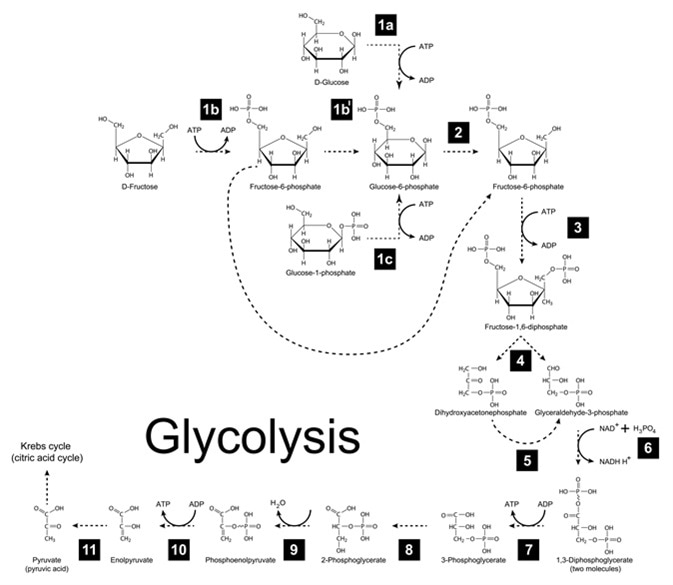Glycolysis is a series of reactions that helpextract energy from glucose. This is an ancient pathway of metabolism that is present in the majority of living organisms today. It is the foundation of both aerobic and anaerobic cellular respiration. It takes place in the cytosol of a cell and is the foundation of both aerobic and anaerobic cellular respiration.
The following the simplified equation represents the overall reaction of glycoysis:
C6H12O6 + 2 NAD+ + 2 ADP + 2 P à 2 pyruvic acid, (CH3(C=O)COOH + 2 ATP + 2 NADH + 2 H+
However, the real process is much more complicated and can be separated into two broad phases: the energy-requiring phase and the energy-releasing phase. Each of these is covered in more detail below.
Energy-Requiring Phase (Energy Investment Phase)
The first step is for the glucose molecule to split into two three-carbon molecules, which are known as pyruvates. There are a number of steps that must occur for this to happen.
- Hexokinase converts glucose into glucose-6-phosphate using one ATP, which is converted to ADP.
- Phosphoglucose isomerase converts glucose-6-phosphate into fructose-6-phosphate.
- Phosphofructokinase converts fructose-6-phosphate into fructose-1,6-bisphosphate using one ATP, which is converted to ADP.
- Bisphosphate aldolase catalyzes the reaction to convert fructose-1,6-bisphosphate into two three-carbon molecules: glyceraldehyde-3-phosphate and dihydroxyacetone phosphate (DHAP).
- Triose phosphate isomerase catalyzes the conversion of DHAP to glyceraldehyde-3-phosphate. This is a reversible reaction but DHAP is eventually depleted because glyceraldehyde-3-phosphate continues in the next phase of glycolysis.
The glucose molecule is rearranged so that two phosphate groups are able to attach to it. This reaction requires energy in the form of two ATP molecules. The molecule is now unstable and referred to as fructose-1,6,-bisphosphate.
From this point, the molecule can split to form two three-carbon sugars with a phosphate group attached, known as glyceraldehyde-3-phosphate and DHAP, which is also converted to form glyceraldehyde-3-phosphate.
This phase is known as the energy-requiring phase or the energy investment phase because energy in the form of ATP is needed in order to form the unstable fructose molecule from glucose.

Chemical scheme of glycolysis metabolic pathway - Image Credit: chromatos / Shutterstock
Energy-Releasing Phase (Energy Payoff Phase)
In the energy-releasing phase, the glyceraldehyde-3-phosphate molecules are converted to three-carbon sugars without the phosphate group, known as pyruvate.
This reaction releases energy as the molecules become more stable by converting one NAD+ to NADH and two ADP to ATP for each glyceraldehyde-3-phosphate molecule.
The detailed steps of the energy-releasing phase of glycolysis are as follows:
- A redox reaction occurs to convert glyceraldehyde-3-phosphate into 1,3-bisphosphoglycerate, releasing an H+ ion from NAD+ to for NADH at the same time.
- Phosphoglycerate kinase converts 1,3-bisphosphoglycerate to 3-phosphoglycerate, simultaneously converting ADP to ATP.
- Phosphoglycerate mutase converts 3-phosphoglycerate to 2-phosphoglycerate.
- Enolase converts 2-phosphoglycerate to phosphoenolpyruvate (PEP), simultaneously releasing a molecule of water.
- Pyruvate kinase converts PEP to pyruvate, simultaneously converting ADP to ATP.
Glycolysis: An Overview
Products of Glycolysis
When both the energy-requiring and energy-releasing phase of glycolysis have occurred, the products of the overall reaction include two pyruvate molecules, two ATP molecules, and two NADH molecules.
In the presence of oxygen, the pyruvate molecules can be broken down via oxidation in cellular respiration to form more energy in the form of ATP and carbon dioxide. The NADH molecules cycle back and forth between the oxidized and reduce states (NAD+ and NADH).
References
Further Reading
Last Updated: Feb 26, 2019